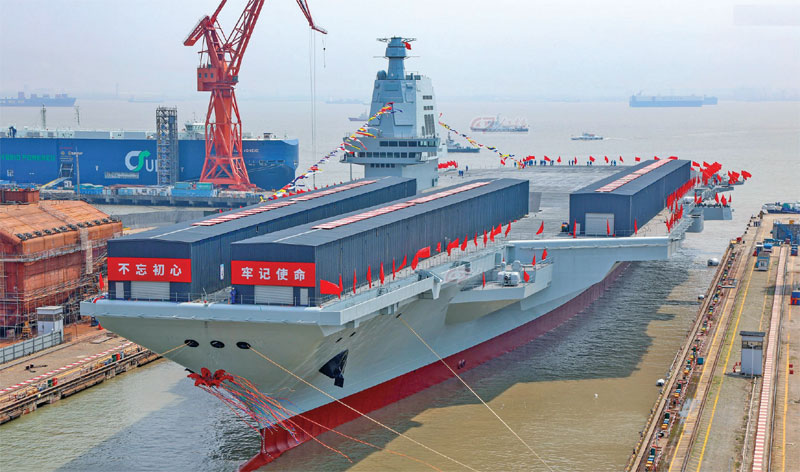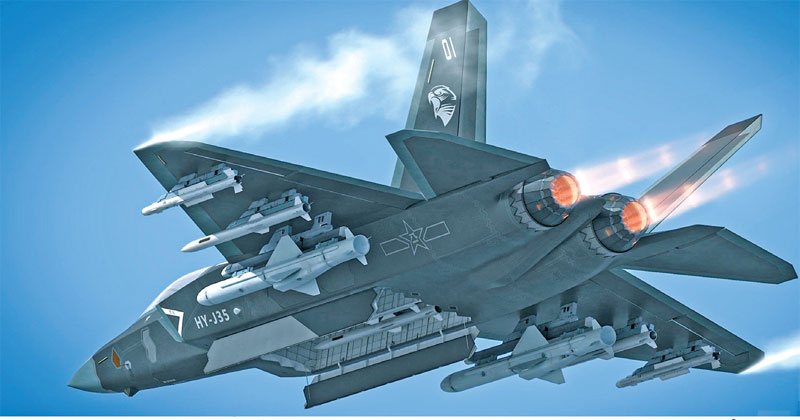China’s launch of the third aircraft carrier marks the maturing of its shipbuilding
Prasun K. Sengupta
China on June 17, launched its third and most advanced aircraft carrier from Shanghai’s Jiangnan Shipyard (located on Changxing Island). Named ‘Fujian’, the 80,000-ton vessel is China’s first domestically designed and built catapult-assisted take-off but arrested recovery (CATOBAR) aircraft carrier that also hosts an electromagnetic catapult-assisted launch system that comprises three separate launch-rails.

China’s first aircraft carrier, the 60,900-ton Liaoning CV-16, was an unfinished Soviet-era vessel that Beijing bought from Ukraine in 1998, updated by the Dalian Shipbuilding Industry Company (DSIC) and finally commissioned on 25 September 2012. The second aircraft carrier, a replica of the Liaoning, was the Shandong CV-17, which was laid down in March 2015 and launched on 26 April 2017. The fitting out was completed on 25 April 2018. It was commissioned on 17 December 2019. Both the Liaoning and Shandong have a top-deck designed for short take-off but arrested recovery (STOBAR) flight operations.
The Fujian’s keel was laid in March 2015. The various block modules were moved from the manufacturing facility to the staging area in May 2020, and into the dry-dock in July 2020. Almost all of the keel and base hull-blocks were in the dry-dock by early September 2020; with the foremost part of the bow missing at that time. Superstructure measurements based on satellite photography suggest a hull/ waterline length of 300 metres and a maximum beamwidth of 40 metres. The propulsion system comprises four marine industrial gas-turbines imported from Ukraine’s Zorya-Mashproekt. The principal combat and combat-support aircraft to go on board the Fujian will be the under-development Shenyang J-35 M-MRCA and the Xi’an KJ-600 airborne early warning and control system.
The Fujian will also have on board a variety of technological marvels coming out of a consortium of the PLA Navy’s (PLAN) R&D institutions that have claimed to have achieved vital developmental breakthroughs in the arenas of integrated electric propulsion systems (IEPS), pump-jet propulsion systems for nuclear-powered submarines, high-energy warship-mounted laser-based directed-energy weapons for air-defence, and superconductive magnetic anomaly detection (MAD) arrays. The involved institutions include the Lake Huangjia-based Wuhan Naval Research Institute, China Shipbuilding Industry Corp’s (CSIC) wholly-owned Wuhan Institute of Marine Electric Propulsion (WIMEP)—also known as the 712 Research Institute—and the Shanghai Jiaotong University’s Department of Micro/ Nano Electronics.
Back in early 2016, Beijing had established a Scientific Research Steering Committee to help it develop cutting-edge military technologies. This body was modelled on the US Defense Advanced Research Projects Agency (DARPA), which was set up after the USSR’s Sputnik satellite launch in 1957 to spearhead R&D on pioneering military systems to maintain the US’ qualitative edge over the Soviet Union. The Steering Committee has since been working with the PLA’s Science and Technology Commission, which was set up in 2015 and also reports to the Central Military Commission. The Committee has since been focussing on developing not only the hardware but also the related applications software packages.

It was in August 2013 that the CSIC-owned WIMEP had first revealed the design of a gas turbine-based IEPS for future warships. An IEPS uses a gas-turbine or diesel-generator to produce electricity that powers motors, which turn propeller shafts or operate waterjets. The system significantly does away with heavy mechanical clutches and highly sophisticated reduction gearboxes that reduce or increase power to the propeller shafts. It also saves space and weight and is easier to control and maintain. It is also quieter to run and can increase a warship’s speed over conventional diesel-engines.
The PLAN’s Rear Admiral Ma Weiming, who led the developmental effort of such an IEPS, has claimed that the WIMEP-developed solution is the world’s first IEPS to run on a medium-voltage, direct-current system. The WIMEP-developed rim-driven pumpjet has a ring-shaped electrical motor inside the pumpjet shroud, which turns the vane rotor (a vane rotor has the fan blades attached to a rotating band built on a cylinder interior, as opposed to a propeller shaft) inside the pumpjet cavity to create thrust. Previous submarine-mounted pumpjets were ‘shrouded propellers’, which consisted of a tubular nozzle covering the propeller. By removing the shaft of the propeller, the reduction in the number of moving parts decreases the noise made by the pumpjet, as well as saving hull space.
In addition, rim-driven pumpjets are easier to maintain, and have less cavitation (bubbles that form during propeller movement), making them even more quiet. The PLAN’ futuristic Type 09-V SSNs and Type 09-VII SSBNs will incorporate such IEPS and rim-driven pumpjets.

The PLAN’s electromagnetic aircraft launch system’s R & D facility (inclusive of a full-scale operational prototype) is located at Ningbo-Zhuangqiaoin. Developmental work on this system began in the late 1990s and by 2015 an operational prototype was successfully developed.
Rear Admiral Ma Weiming, 57, became a household name in 2011 when he announced during a speech to accept a national technology award that his team had successfully developed an electromagnetic catapult-assisted launch system. Ma, a PLA deputy to the National People’s Congress, hails from Yangzhou in Jiangsu. He graduated from the PLAN’s University of Engineering in Wuhan, Hubei, in 1987 and subsequently elected to teach there. He earned a PhD in electrical engineering from Tsinghua University in 1996 and went on to become the country’s youngest engineering academician five years later.
A specialist in maritime propulsion, electrical engineering and related fields, Ma has cultivated/ mentored more than 400 Masters and PhD students at the PLAN’s University of Engineering since the late 1980s. Ma’s exalted status in the PLAN was highlighted by a photograph of then PLAN Commander Admiral Wu Shengli holding an umbrella for Ma during an inspection of the University of Engineering in Wuhan, where Ma works, on a rainy day in June 2016. Rear Admiral Liu Dezhi, a colleague at the university, describes Ma as a workaholic and master problem-solver.
Dubbed the father of China’s electromagnetic catapult-assisted launch system, Rear Admiral Ma describes himself as a ‘teacher without any dreams’. He is one of 17 nominees for 10 Order of August 1 awards that were presented by President Xi Jinping on 1 August 2015, the 90th anniversary of the founding of the Red Army, the PLA’s precursor. In the past, Ma had won the National Science and Technology Progress Award twice and in 2015 also won the science and technology achievement prize of the Ho Leung Ho Lee Foundation, a Hongkong SAR-based non-government organisation.

